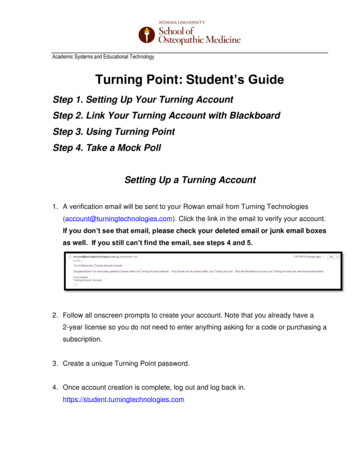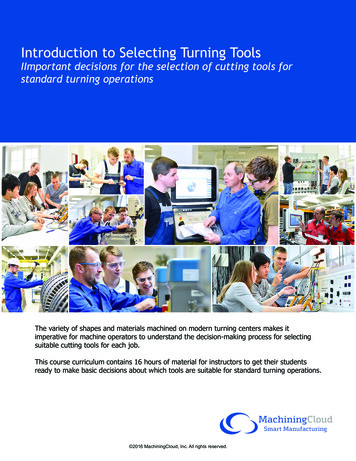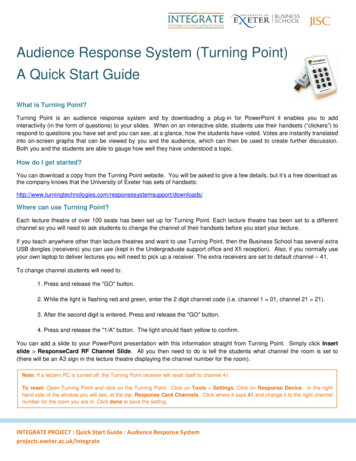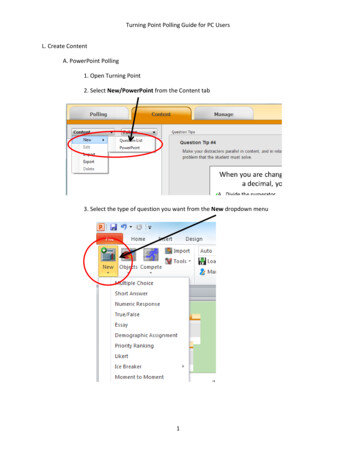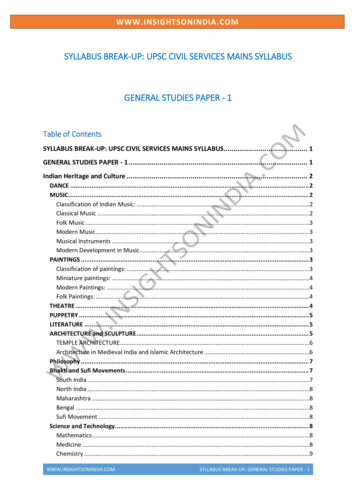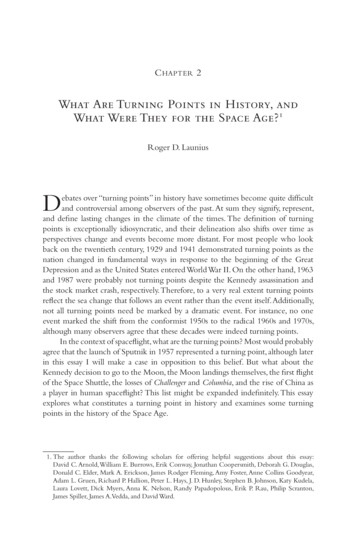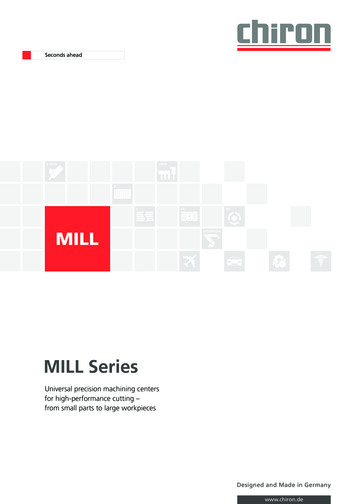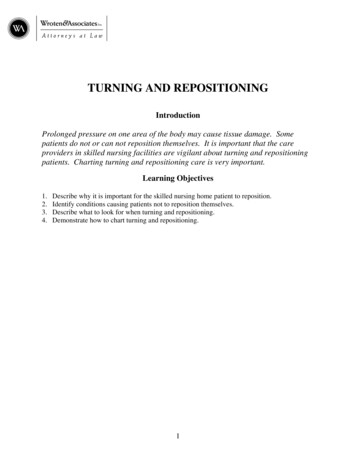
Transcription
TURNING AND REPOSITIONINGIntroductionProlonged pressure on one area of the body may cause tissue damage. Somepatients do not or can not reposition themselves. It is important that the careproviders in skilled nursing facilities are vigilant about turning and repositioningpatients. Charting turning and repositioning care is very important.Learning Objectives1.2.3.4.Describe why it is important for the skilled nursing home patient to reposition.Identify conditions causing patients not to reposition themselves.Describe what to look for when turning and repositioning.Demonstrate how to chart turning and repositioning.1
LessonProlonged periods in a one position can result in tissue breakdown and discomfortfor patients. Patients may not be able to reposition themselves for many reasonsand rely on caregivers to assist them. Caregivers must be alert to the risk of tissuedamage, the conditions that prevent independence in turning and repositioning, theproper technique for turning and repositioning and the proper documentation forrepositioning care.Why reposition?S,INC.You may recall a time when you woke up after sleeping hard and had wrinkles inyour skin or your arm felt tingly. This occurs from lying in one position for aprolonged period of time.SOCIATEIn healthier individuals, the body can withstand longer periods in one positionwithout tissue breakdown however, many long term care patients suffer tissuebreakdown if maintained in one position for too long.TEN&ASOur aging patients often have skin that is thinner and less resistant to trauma. Thepadding over the bony areas thins and the patient is more susceptible to tissuedamage from prolonged positions. Our patients often have illnesses that makethem more susceptible to injury or infection.WROProper turning and repositioning is a method to reduce the chance of tissuebreakdown and wound development.Tissue breakdown may mean that a wound develops on the outside of the body.This wound may provide an opportunity for infection to set in. It is important thatwhenever possible, wounds be avoided.2
Is my patient at RISK?Not all wounds can be avoided. It is important to identify patients who are atgreater risk for developing tissue breakdown, including wounds, so thatpreventative treatment can be attempted.In order to identify patients at risk, you must be familiar with your patient, theirdiagnoses and their needs. If you are uncertain whether your patient is at risk it isimportant that you speak with the charge nurse, DSD, supervisor or Director ofNursing.S,TEASSOCIAPatient who are immobile for any reason.Stroke victims.Patients with neuropathy from diabetes.Comatose patients.Patients with casts or braces.Spinal cord injuries.Some Alzheimer’s patients.Post-surgical patients.INC.Patients who are at higher risk include:TEN&Patients with chronic diseases that put them at greater risk for tissue breakdowninclude those with:WRODiabetes.Blood flow problems.Swelling ion.Patients with prominent (stick out) bones.Fever.Anemia.Patients with confusion, forgetfulness and other mental conditions.History of smoking.Existing wounds.3
Steps To Prevent Tissue BreakdownEducate the patient and family on the need to reposition.Encourage patients who can reposition independently to do so, but monitor theircompliance.Encourage food and fluids within the patient’s diet.Follow the turning and repositioning schedule established at your Center.INC.Monitor routinely for incontinence and promptly change the patient.TES,Know you patient’s treatment plan. If there are reddened areas or areas of skinbreakdown, discuss repositioning options with the DSD or treatment nurse.IAProvide routing hygiene and skin care.WROTEN&ASSOCProvide range of motion exercises with repositioning as outlined in the treatmentplan.4
Pressure Points MostVulnerable to BreakdownWROTEN&ASSOCIATES,INC.Some areas of the body are more susceptible to pressure due to the bones in thearea.5
TURNING AND REPOSITIONINGPROCEDURES1. Identify your patients who require turning and repositioning.2. Follow the turning and repositioning schedule. Repositioning is not just forpatients in bed. The repositioning schedule also applies to patients in the chairor wheelchair.3. Wash your hands before any patient contact.S,5. Tell the patient/family what you are going to do.INC.4. Assemble all supplies.IATE6. Provide hygiene care as needed to keep the patient’s skin clean and dry.ASSOC7. Avoid friction when moving the patient. Friction is caused by the skin rubbingacross the sheets or clothes. Lift and turn, do not drag the patient.WROTEN&8. Avoid shearing of the skin whenever possible. Shearing is caused bydownward pressure of gravity pulling the patient to the foot of the bed. Thisoften occurs when the head of the bed is elevated. Shearing may beunavoidable when the head of the bed must be elevated due to other healthconditions.9. Manage moisture caused by incontinence or perspiration because it can causethe skin to be more susceptible to breakdown.10. Maintain your body alignment and that of the patient when you are turning andrepositioning the patient. Request assistance from a co-worker whenevernecessary to avoid injury to yourself and your patient. Use pillows and/orrepositioning devices as outlined in the patient’s treatment plan.11. Keep the linens and clothing free from wrinkles that may cause impressions inthe skin.12. Observe the bed and chair surfaces and compare them to what the care plancalls for. If they are not the same, tell the charge nurse, DSD, or treatment6
nurse about your concern.13. Observe the patient’s feet/heels. If the care plan calls for heel protectors, seethat the heel protectors are in place. If the care plan calls for floating of theheels, float the heels with pillows under the calves to avoid pressure on theheels. If the care plan calls for a foot cradle, see that the foot cradle is in placeand is not putting pressure on the patient’s feet.14. Observe the area of skin that was previously in contact with the bed or chair forredness or breakdown. If there is redness or breakdown, promptly chart yourobservation and tell the charge nurse, DSD, or treatment nurse.S,INC.15. Bathe your patient and massage the skin with lotion as part of the routinehygiene program. Avoid massage directly on a reddened area.]IATE16. Clear the bed of any food crumbs, bandages, discarded clothing or other itemsthat may prevent a smooth surface.&ASSOC17. Encourage independent turning and repositioning whenever possible and fluidand food intake as prescribed. Also encourage the patient to communicate anydiscomfort.TEN18. Replace the bedside rails, alarms or other restraint devices if they are part ofthe patient’s care plan.WRO19. Replace the call light within the patient’s reach.20. Offer fluids during the repositioning process if there are no fluid restrictions.7
DOCUMENTATIONThere are two important opportunities for documentation regarding yourpatient’s turning and repositioning.2.When you inspect your patient’s skin after with turning and repositioning,any redness, blistering, bruising, abrasion or breakdown is documented inthe area designated for CNA documentation (often on the back of theactivities of daily living form). This information is also promptly sharedwith the charge nurse, DSD or treatment nurse.3.Activities of Daily Living flow sheets. Most Centers have a flow sheet forCNAs to document turning and repositioning. Each shift accuratelydocument the turning and repositioning that you have done, using the backof the form for any notes of significance for that shift.IATES,INC.1.&ASSOCOur Center’s goal is to maintain the turning andrepositioning schedule of our patients 100% of thetime.WROTENYour goal is to maintain the turning and repositioningschedule of your patients 100% of the time.If you need help, ask a teammate for assistance. If youskin changes, chart it and tell the appropriate person.8
Post-TestQuestion 1Which of the following conditions does not place a patient at higher risk for skinbreakdown?A. ParalysisB. DiabetesC. History of smokingD. All of the aboveS,INC.Question 2Lotion should not be used on bedridden patients because it creates an increase inmoisture build-up.IATEA. TrueSOCB. FalseN&ASQuestion 3It is not important to tell anyone about redness observed on the skin because it islikely to disappear.ORWB. FalseTEA. TrueQuestion 4Tissue damage and skin breakdown are avoidable in all cases in nursing homepatients.A. TrueB. False9
Question 5It is acceptable to chart my turning and repositioning in the patient’s recordsometime later in the week if I am too busy to chart it the day it is done.A. TrueWROTEN&ASSOCIATES,INC.B. False10
Post-TestQuestion 1Which of the following conditions does not place a patient at higher risk for skinbreakdown?A. Paralysis. (Partially correct-Patients who might be at higher risk for skinbreakdown include stroke victims, diabetic neuropathy, comatose or paralyzedpatients, patients with casts or braces, Alzheimers or dementia, confused ordepressed patients, post-surgical patients, patients with blood flow problems,swelling, obesity, undernourished/skinny, incontinent, fever, anemia or thosewith pre-existing wounds.)CIATES,INC.B. Diabetes. (Partially correct-Patients who might be at higher risk for skinbreakdown include stroke victims, diabetic neuropathy, comatose or paralyzedpatients, patients with casts or braces, Alzheimers or dementia, confused ordepressed patients, post-surgical patients, patients with blood flow problems,swelling, obesity, undernourished/skinny, incontinent, fever, anemia or thosewith pre-existing wounds.)TEN&ASSOC. History of smoking. (Partially correct-Patients who might be at higher risk forskin breakdown include stroke victims, diabetic neuropathy, comatose orparalyzed patients, patients with casts or braces, Alzheimers or dementia,confused or depressed patients, post-surgical patients, patients with blood flowproblems, swelling, obesity, undernourished/skinny, incontinent, fever, anemiaor those with pre-existing wounds.WROD. All of the above. (Correct-Patients who might be at higher risk for skinbreakdown include stroke victims, diabetic neuropathy, comatose or paralyzedpatients, patients with casts or braces, Alzheimers or dementia, confused ordepressed patients, post-surgical patients, patients with blood flow problems,swelling, obesity, undernourished/skinny, incontinent, fever, anemia or thosewith pre-existing wounds.Question 2Lotion should not be used on bedridden patients because it creates an increase inmoisture build-up.A. True. (Incorrect-Moisture is beneficial to patients because it moisturizes dryskin, may create a protective barrier to the skin, may provide healing benefitsfrom human touch and may stimulate circulation to the skin.)11
B. False. (Correct-Moisture is beneficial to patients because it moisturizes dryskin, may create a protective barrier to the skin, may provide healing benefitsfrom human touch and may stimulate circulation to the skin.)Question 3It is not important to tell anyone about redness observed on the skin because it islikely to disappear.INC.True (Incorrect—While skin redness may be temporary in some cases, it may alsobe a sign that tissue beneath the surface of the skin is damaged. It is importantto communicate this observation in two ways: 1) document the findings in thepatient’s medical record and 2) tell the charge nurse, DSD or treatment nursepromptly.)SOCIATES,False (Correct—While skin redness may be temporary in some cases, it may alsobe a sign that tissue beneath the surface of the skin is damaged. It is importantto communicate this observation in two ways: 1) document the findings in thepatient’s medical record and 2) tell the charge nurse, DSD or treatment nursepromptly.)N&ASQuestion 4Tissue damage and skin breakdown are avoidable in all cases in nursing homepatients.WROTEA. True. (Incorrect.-Despite the best of care some patients have tissue damage orskin breakdown. In any event it is important to following the turning andrepositioning procedure outlined by your Center to support the healing processof existing tissue damage and skin breakdown and, if possible, prevent furtherdamage.)B. False. (Correct.-Despite the best of care some patients have tissue damage orskin breakdown. In any event it is important to following the turning andrepositioning procedure outlined by your Center to support the healing processof existing tissue damage and skin breakdown and, if possible, prevent furtherdamage.)12
Question 5It is acceptable to chart my turning and repositioning in the patient’s recordsometime later in the week if I am too busy to chart it the day it is done.A. True. (Incorrect-Charting needs to be done as close in time as possible as thecare is given. It is unlikely and impractical to try to recall the care you provideddays prior. Also, charting for care to be provided in the future is not allowedunder any circumstances.WROTEN&ASSOCIATES,INC.B. False. (Correct. Charting at a time as close as possible to when the care wasprovided or the observation was made provides a more thorough record for theteam providing care and is likely to provide the most accurate information.Charting for care to be provided in the future is not allowed.13
WROTEN & ASSOCIATES, INC. 4 Steps To Prevent Tissue Breakdown Educate the patient and family on the need to reposition. Encourage patients who can reposition independently to do so, but monitor their compliance. Encourage food and fluids within the patient's diet. Follow the turning and repositioning schedule established at your Center.
